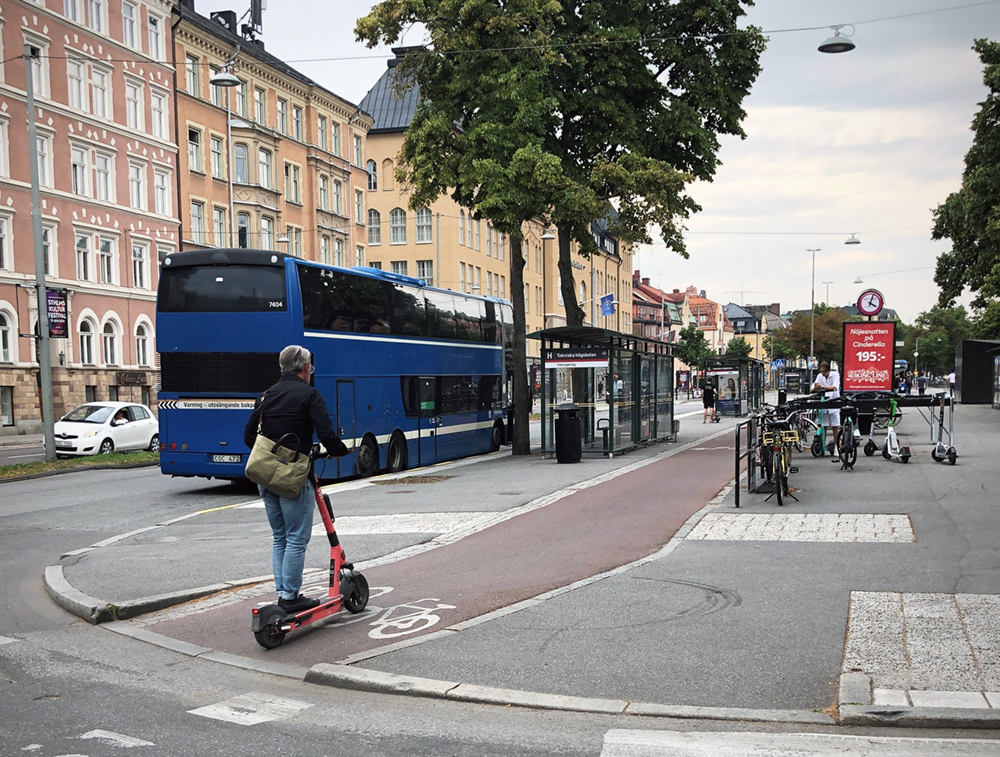Electric scooters less popular since introduction of new parking rules

Fewer e-scooters and parking racks a long way from the user’s destination. These may be a couple of reasons why the use of e-scooters has decreased with the introduction of new parking rules last autumn.
Following complaints by the public and political debate, national parking rules were introduced for electric scooters last autumn. From 1 September, users could no longer park their e-scooters practically anywhere. Parking is now only permitted in cycle racks or designated places.
Via a survey answered by people who use shared e-scooters from operator Voi in Stockholm, Gothenburg and Malmö, traffic researchers at KTH wanted to get an idea of how the new rules have been received.
According to the responses, users felt that access to e-scooters and the ability to park close to their destination both worsened after 1 September. The dissatisfaction applied both to the locations of the parking zones and how far apart they are.
In Stockholm, 62 per cent of a total of 965 people, and in Malmö, 60 per cent of 159 people, said that they’ve reduced their travel by e-scooter. It is natural for the use of e-scooters to decrease during the autumn, but the researchers still believe that the new rules are behind the downward figures. This is supported by the figures for Gothenburg, for example, where the restrictions have not yet been applied and use has not decreased by as much.

“In our view, the parking restrictions led to changes in travel patterns. We hope to be able to confirm the figures this autumn using travel data from the vehicles themselves,” says Boel Berg Wincent , a PhD student at the Centre for Traffic Research and author of a research report.
Stockholm a role model
At the same time, many users liked the fact that stricter parking rules have been introduced.
“I was surprised that so many people were positive about the changes. I thought it would be the reverse. But obviously a lot of people think that the rules are needed, the people who use the e-scooters have themselves seen a problem,” says Berg Wincent.
According to the survey, Stockholmers were most satisfied with the new situation. Thirty-eight per cent were positive and 20 per cent were neutral about the new rules. The researchers interpret the results as showing that the introduction of the parking rules has been a success from the perspective of e-scooter users.
“We will also be able to present other perspectives – those of municipalities and operators – later this summer.”
Researchers consider Stockholm a role model in work to design a sustainable system for e-scooters.
“Sweden has come a long way compared with other countries, and Stockholm has an especially good system in several respects: how parking spaces are designed and where they are located. Stockholm may emerge as a city that can be cited internationally as a successful example in the e-scooter issue.”
Link to public transport
Over half of users in all three cities used e-scooters to link to or from public transport. Being a link to the bus, underground, commuter train or tram may be where the greatest potential of the e-scooter lies, according to Wincent.
“It is the issue that all transport engineers want to resolve. The e-scooter is the first successful attempt to solve this on a large scale with something that is easily accessible, relatively inexpensive and easy to use.”
The next step in the research – aside from analysing the travel data – is to study and describe Stockholm’s parking system more closely and in detail.
The survey for the research was produced in autumn 2022 and sent to e-scooter operator Voi’s users in November. A total of 1,584 responses were received.
How is the credibility of the research affected by the fact you are collaborating with Voi, which has its own interests in the issue?
“We have chosen and formulated the survey questions entirely by ourselves. We have compiled and analysed the results and drawn conclusions completely independently of Voi,” says Berg Wincent.
Text: Christer Gummeson
